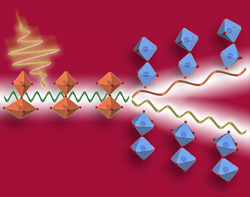The birth of nonlinear phononics
CFEL's MPSD research published in Nature Physics
Michael Först's research published in August nature physics:
The birth of nonlinear phononics
Over the past 50 years, nonlinear photonics has revolutionized the generation and manipulation of light; changing its color is just one of many prominent examples. Now a team of researchers around the CFEL scientists Michael Först and Andrea Cavalleri (Condensed Matter Division - Max Planck Department for Structural Dynamics), including Yoshinori Tokura (AIST, Tsukuba, Japan) and Roberto Merlin (University of Michigan, USA), demonstrated an analogous effect for vibrational modes in crystal lattices. High-amplitude optical excitation of an infrared-active phonon mode led to the generation of a lower-frequency coherent Raman phonon driven through nonlinearities of the crystal lattice. The study was recently reported in Nature Physics.
The observations are explained by the ionic Raman scattering effect – predicted 40 years ago, but hitherto never observed. Comparable to optical rectification in nonlinear photonics, this mechanism rectifies the resonantly excited high-amplitude phonon field to exert a directional force onto the crystal. This force induces an abrupt displacement of the atoms from their equilibrium positions to manipulate the lattice in an unprecedented fashion in order to drive the Raman-active mode – or in the terminology of nonlinear photonics, to generate the “new color”.
Nonlinear phononics, as this work demonstrates for the first time, can be used to control crystal structures in a new way, opening the path to selective lattice modifications impossible with electronic excitations. It leads to new avenues for the control of condensed matter with light, as it can explain recent breakthroughs in vibrationally induced superconductivity, insulator-metal transitions, and magnetic switching.
.
CFEL Publications
